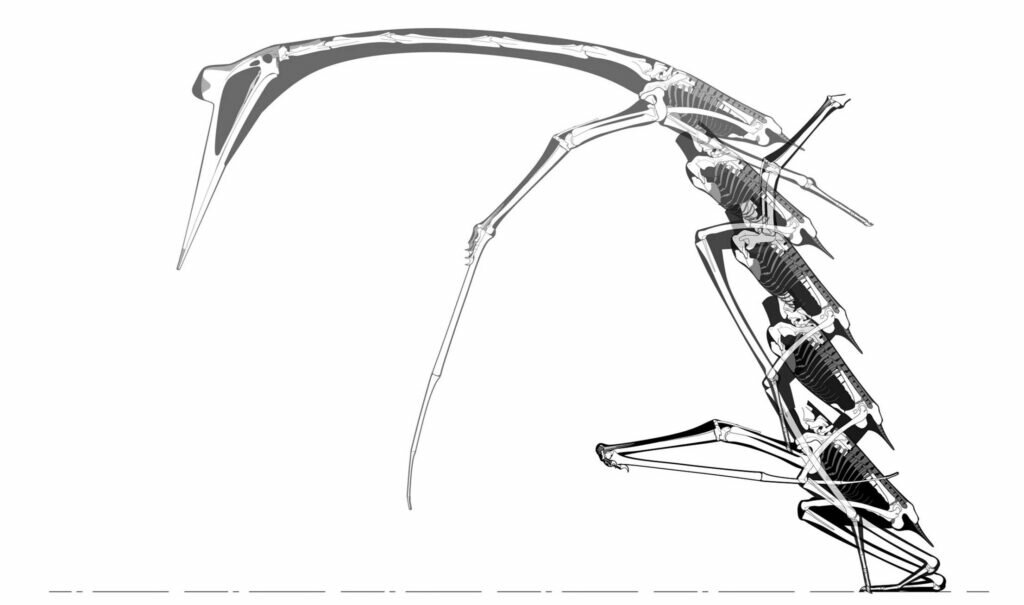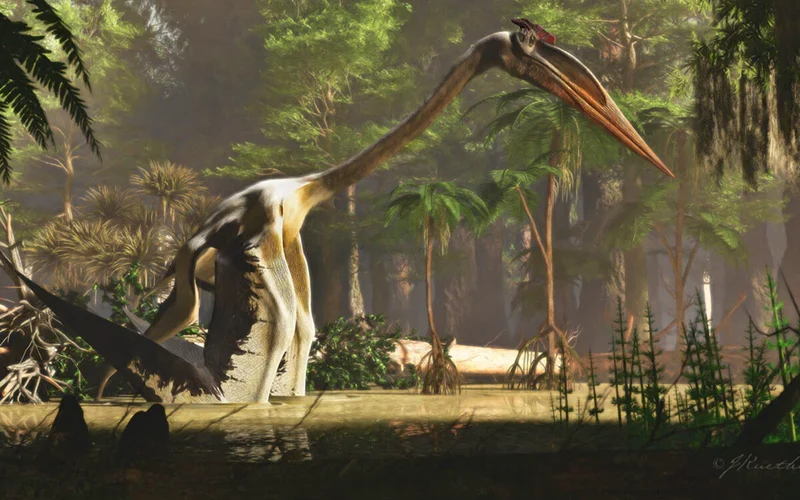With the wingspan of a small aeroplane, Quetzalcoatlus northropi was a pterosaur living in the wetlands of what is now Texas, USA over 67 million years ago.
Researchers have found that its 11-metre-long wings meant it would have had to jump up to 2.5 metres into the air, followed by powerful flaps to pull it into the sky. It would have landed like an airplane, slowing up in the air before touching down on terra firma and taking a hop for stability.
“If they could jump twice their hip height, to eight feet, the wings would be able to clear the ground, and they could execute a deeper flight stroke,” says paleontologist Kevin Padian from the University of California Museum of Paleontology. “This may be the best option for taking off, though it depends on sufficient power from the legs.”
“The animal had to flap its wings to stall and slow its descent before it lands with its back feet and takes a little hop,” Padian explains. “Then it puts down its front feet, assumes a four-legged posture, straightens itself out, and walks away.”
The two Quetzalcoatlus species both called Big Bend home about 70 million years ago, when the region was an evergreen forest instead of the desert of today. But each led a distinct lifestyle, according to Thomas Lehman, who started his research as a doctoral student at the Jackson School and is now a professor at Texas Tech University.
By examining the geological context in which the fossils were found, Lehman determined that the larger Quetzalcoatlus might have lived like today’s herons, hunting alone in rivers and streams. The smaller species, in contrast, appeared to flock together in lakes – either year-round or seasonally to mate – with at least 30 individuals found at a single fossil site.

A step-by-step reconstruction of a proposed Quetzalcoatlus launch sequence.
The pterosaur crouches, leaps and then starts to flap its wings.
Credit: Kevin Padian et al / John Conway.
Once in the air, Quetzalcoatlus would have soared like modern condors and vultures, with suggestions its large head may have helped it to complete turns. Though historic drawings have compared pterosaurs to bats, the wings would have only been attached to the front limbs like those of a bird.
The first proper analysis of smaller bones found at the Texas site has also revealed a smaller, newly identified species – Q. lawsoni, which seems to have had a wingspan of around 4.5 meters (nearly 15 feet). There are significant differences from the larger pterosaur, including in the structure of the skull and the spine.
“This is the first time that we have had any kind of comprehensive study,” says paleontologist Matthew Brown from the University of Texas at Austin. “Even though Quetzalcoatlus has been known for 50 years, it has been poorly known.”
The new findings, spread out over six published papers, give us a better understanding of these prehistoric beasts, and there are likely more species to find. Further study should also be able to answer remaining questions about Quetzalcoatlus, including the shape of its wing membrane.
Other topics covered by the new batch of papers give more insight into the spread, habitat, and evolutionary family tree of the Quetzalcoatlus species. The latest research will likely form the definitive source of reference for these creatures for many years to come.
Having ruled the skies for millions of years, the pterosaurs met the same dramatic end as the rest of the dinosaurs – but through a careful analysis of fossils, we can bring them back to life to some extent.
“‘These ancient flying reptiles are legendary, although most of the public conception of the animal is artistic, not scientific,” says Padian.
“This is the first real look at the entirety of the largest animal ever to fly, as far as we know. The results are revolutionary for the study of pterosaurs – the first animals, after insects, ever to evolve powered flight.”
Sources:
https://www.tandfonline.com/doi/full/10.1080/02724634.2020.1780247
https://www.tandfonline.com/doi/full/10.1080/02724634.2020.1801703
https://www.tandfonline.com/doi/full/10.1080/02724634.2019.1593184
https://news.utexas.edu/2021/12/08/worlds-largest-pterosaur-leaped-aloft-to-fly/

